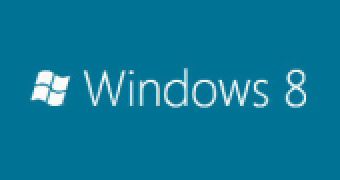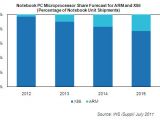Windows 8 is expected to catalyze a shift on the microprocessor (MPU) market, negatively impacting the adoption of traditional x86 CPUs, but nourishing strong growth for ARM processors. IHS iSuppli forecasts that Intel’s x86 architecture, which includes both 32-bit and 64-bit central procession units, will take a hit, uptake-wise, following the launch of Windows 7’s successor, with the market share of ARM chips exploding in the next four years.
In fact, IHS iSuppli notes that ARM-based systems’ share of the global notebook PC unit shipments could grow to as much as 22.9 percent in 2015.
By comparison, in 2012, only 3% of all notebooks offered to customers worldwide will be powered by ARM architectures. According to IHS iSuppli estimates, the volume of ARM notebook shipments will increase almost tenfold, from 7.6 million in 2012 to no less than 74 million in 2015.
“Starting in 1981, when IBM first created its original PC based on Intel’s 8088 microprocessor, the x86 architecture has dominated the PC market,” revealed Matthew Wilkins, principal analyst of compute platforms for IHS.
“Over the next generation, billions of PCs were shipped based on X86 microprocessors supplied by Intel and assorted rivals—mainly Advanced Micro Devices Inc. However, the days of X86’s unchallenged domination are coming to an end as Windows 8 opens the door for the use of the ARM processor, which already has achieved enormous popularity in the mobile phone and tablet worlds.”
The IHS iSuppli conclusions are focused on the evolution of the notebook market, but the fact of the matter is that x86 could be hurt even further, since ARM architectures can be used in a range of additional devices, including Tablet PCs / slates, but also additional next-generation form factors.
The Redmond company first confirmed that Windows 8 would support System on a Chip (SoC) designs, including ARM-based systems in January 2011, and then again this summer. NVIDIA, Qualcomm and Texas Instruments are working with Microsoft to expand chip support with Windows 8.
Customers worldwide ultimately stand to benefit from Windows 8 supporting ARM chips, which are traditionally smaller than x86 processors, while also delivering inferior power consumption levels, a detail which automatically implies superior battery life.
However, ARM architectures are not capable of matching x86 CPUs in terms of performance, so they’ll most likely be packed inside cheaper devices, under $700, in products such as value notebooks.
“ARM is well-suited for value notebooks, where performance isn’t a key criterion for buyers,” Wilkins added. “Value notebook buyers are looking for basic systems that balance an affordable price with reasonable performance. ARM processors deliver acceptable performance at a very low cost, along with unrivaled power efficiency.”

 14 DAY TRIAL //
14 DAY TRIAL // 
